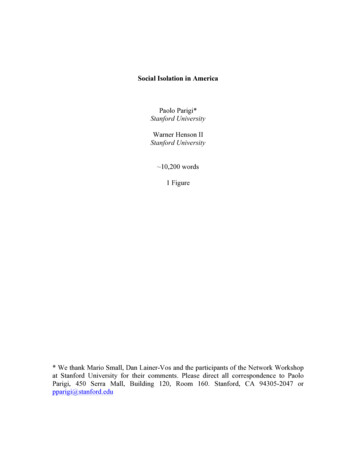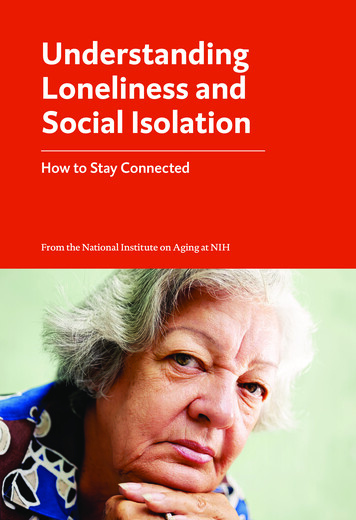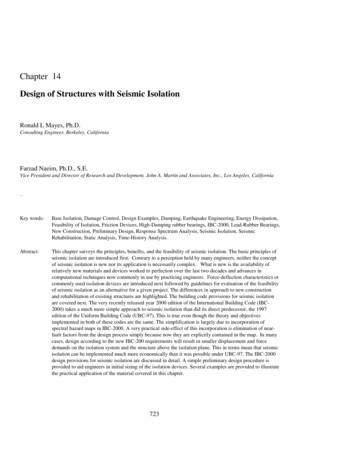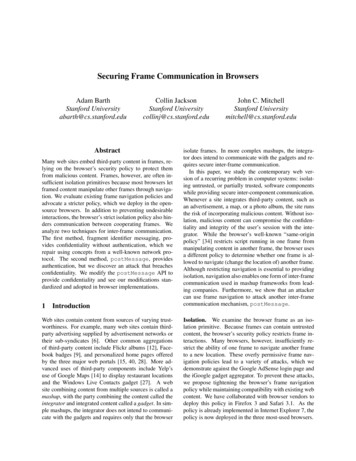
Transcription
Social Isolation in AmericaPaolo Parigi*Stanford UniversityWarner Henson IIStanford University 10,200 words1 Figure* We thank Mario Small, Dan Lainer-Vos and the participants of the Network Workshopat Stanford University for their comments. Please direct all correspondence to PaoloParigi, 450 Serra Mall, Building 120, Room 160. Stanford, CA 94305-2047 orpparigi@stanford.edu
Abstract: In this paper we offer a new measure for social isolation for the contemporarysociety where opportunities for making connections with others have become ubiquitous.We develop this measure after reviewing previous research on social isolation that wesegment into two perspectives. On the one side, isolation has been studied as a negativeoutcome of processes related to modernization; on the other side, isolation has beenstudied as a structural position potentially capable of delivering positive returns.Although academic interest in isolation is longstanding, recent years have seen anoutburst of research on the topic. The paper explores the connection this outburst andnew social media and highlights a division within the literature between researchers whosee new social media as creating more feelings of isolation and others who think that thejury is still out. In the final section of the paper we offer our novel conceptual frameworkfor studying isolation.Keywords: Social Isolation, New Social Media, Social Networks.2
A question for our timeAre contemporary Americans more isolated than ever before? American sociologists havereturned to this question repeatedly over the past century. At the heart of the enduring interest inisolation lie two interrelated approaches, (a) the connection that many social scientists havedrawn between modernity and the American experience and (b) the role of technology as adisruptive social force. Social isolation is a topic where the creed of American exceptionalism(Bellah 2007, Riesman et al. 2001, Lipset 1997) and theoretical considerations about modernity(Schmidt 2012, Eisenstadt 2003, Giddens 1990) have historically met to produce a successfulresearch niche. An example of such a marriage comes from Richard Sennett‘s (1992) argumentthat time dedicated to private life in America has in large part replaced what in 18th-centuryEurope used to be called public life, i.e., time dedicated to interactions with people outside theimmediate circles of one’s family and friends. This has made Americans potentially more isolatedcompared to Europeans (Olds 2010, Pappano 2001). As the next sections will make clear,Sennett’s argument is one in a long line of theories and research that have linked modernity toisolation focusing, in particular, on the American experience.Notwithstanding this abiding interest in isolation, recent years have seen an explosion ofresearch on the topic. Indeed, social scientists (Klinenberg 2012; Conley 2010) and other writershave published several popular books on isolation with a particular focus on loneliness (e.g. Slade2012, Joiner 2011, White 2010). To some degree, technological innovation is at the heart of thelatest surge of studies on isolation and loneliness. One of the most influential scholars of socialisolation, Claude Fischer, writes: “The most visible development of the last forty years has beentechnological innovation. Modern cars and planes, email, cell phones, text messaging, videolinks, and social networking sites have vastly expanded, sped up, and lowered the cost of socialinteraction” (2009:4). Technology and new social media (NSM, hereafter) in particular haveprofoundly reshaped the ways in which Americans relate to each other and the meaning they3
derive from such relationships. As we shall see, competing views about the effects oftechnological innovation and its resulting impact on Americans will provide the basis for a richdebate on the relationship between social isolation to the fragmentation of society along the faultlines of race, politics, and immigration. A more fragmented society does not necessarily imply thecreation of more social isolation (Fischer & Mattson 2009).Seeing technology as a disruptive social process has a long tradition that predates theinvention of the Internet (Segal 1994) and it is part and parcel of the American exception (Pursell1981). This perspective was demonstrated by Thomas Jefferson through his role in thedevelopment of the United States patent office (see for example Bedini 1990, Martin 1952). Thescope of the argument transitioned into politics during the period of Jacksonian democracy, whentechnology was seen as a way to reduce inequality and ameliorate living conditions (Barber 1990,Ashworth 1983). Today, many see NSM as powerful tools profoundly reshaping the ways weconduct our lives and establish relationships (Wellman et al. 2002, Marche 2012). Technology,some argue, is making us feeling more isolated. By using an historical approach, we can explainnot only the persistent interest in isolation among American social scientists but also the role thattechnology plays in the recent appeal of the topic to wider audiences (Marvin 2009).Placing the current interest in social isolation within a larger historical context linked totechnological innovation allows us to reformulate the initial question of our essay: “Are NSMmaking Americans more isolated?” Or as Sherry Turkle puts it: “Technology reshapes thelandscape of our emotional lives, but is it offering us the lives we want to lead? (2011, p. 17). AsMichel Foucault pointed out in response to the discussion of human nature, the questions we askand the answers we provide depend heavily on the intellectual climate we live in (Chomsky &Foucault 2006, see also Wilkin 2011). Part of the goal of this paper is to provide a novel answerto such a question that reflects a contemporary social world where the opportunities to makeconnections with others have become ubiquitous. We have moved from living in a world wheresocial connections required considerable investment of time to a world where connections are4
widely available and cheap to establish. We think that the image of an individual’s networksmade by few strong ties and several weak ties does not fully capture the multiple social contextswe live in and therefore a new concept and measure of isolation is needed. As we elaboratebelow, our approach is based on combining two perspectives on isolation—one that considersstructural characteristics of individual networks and another that considers subjective feelings(see for example, Wilkening 1951 for the effects of social isolation on policy adoption). Theunderlying assumption is that social ties are important because they generate meaning for the twopeople that share a connection (White 1995a, White 1995b) and that keeping disparate meaningstogether, i.e., ties from diverse social contexts, can create a dissonance (Bearman & Moody 2004)that produces feelings of loneliness.Before presenting our thoughts on isolation in contemporary society we review in detailwhat others have written on the topic. We organize our review in the following fashion: we divideresearchers that see isolation as a (negative) byproduct of modernity from researchers that haveinterpreted isolation from a structural approach. Here, we amplify the distinctions that separatethe two approaches in order to make our analytical argument more straightforward. In practice,many researchers in the two camps have crossed lines and have interpreted the structural positionof the isolate through the lenses of history.1 Yet a key difference remains: whereas researchers inone camp conceptualize isolation as a historical phenomenon linked to the bundle of processesthat compose modernity—secularization, democratization, capitalism, mass society, urbanism,etc.—the other perspective sees isolation as a position within many societies, including premodern ones (Simmel 1951), capable of producing positive as well as negative effects.We use the above analytical distinction as the theoretical basis for studying the impact ofNSM. Among researchers that study NSM a similar split to the one outlined above emergesbetween researchers that see online interactions as a historical process that is creating lessbonding interactions, i.e., more isolation, and those that argue the NSM are re-structuring the1We thank the anonymous reviewer for helping us seeing this point more clearly.5
social space, opening the doors to new and increasing forms of interactions as other technologieshave done in the past. In the concluding sections of this review, we reconcile the two approacheson NSM and to a certain degree, the two larger approaches on social isolation, by proposing that amore appropriate image of the social isolate is no longer (exclusively) a person with no friendsbut rather a person with so many friends that her resulting cognitive cost of navigating the socialspace generates feeling of loneliness.Isolation as a byproduct of modernityModernity has been characterized as the weakening of the traditional bonds that used toconnect people to their communities and extended kinship groups (Tonnies 1887 [1988]). AsGeorge Homans (1941) noted, villagers of all statuses in 13th-century England had obligations tothe overall community that reduced their freedom in how to pray, what to plant, when and what toeat, and even whom to marry (Luhmann 1998). Before the modern period, society had peasants,lords, kings, queens, priests, popes, etc. but not single individuals. Communities came beforepersons and defined them. Without the concept of the individual—which implies a certain degreeof freedom in the private sphere—the malaise of social isolation could not take hold. Socialisolation is seen from this perspective as an undesirable and (almost) inevitable byproduct ofmodernity (Useem 1980).Several social scientists linked social isolation with the notion that modern life wasanomic and alienating (see Seeman 1975 for a review). Known as the “lost communityhypothesis” (Wellman 1979) it has been a theme in American sociology since its early days.Writing in the 1930s, Luis Wirth for instance argued that the population density, specializationand cultural heterogeneity of modern urban life undermined community and family bonds,thereby producing isolation (1938). Theoretical constructs about modernity have served as themain vehicle for the steady interest in community and its opposite, i.e., social isolation (Mirande1973, Martison 1976). For instance, at the height of Talcott Parson’s influence on American6
sociology, Jesse Pitts wrote: "A crucial aspect of functional analysis is the diagnosis of theAmerican family as having reached the maximum level of isolation, just as American society hasreached the maximum level of industrialization and general role differentiation” (1964, p.88; seealso Yamane & Nonoyama 1967). As Doug McAdam and Ronnelle Paulsen (1993) noticed,social isolation was an essential part of the theory of mobilization in the sense that isolatedmembers of society were theorized to be more likely to protest (see also Leighley 1990, Snow etal. 1980)In this vein, scholars also made the connection between modernity and for societiesoutside of the United States (Saith 2001). Writing about the industrial development of Japan, forexample, Yamane and Nonoyama (1967) argued that modernity facilitated the weakening of theJapanese traditional extended kinship group, the Dozuko, which resulted in an increase in anomie.Gerald Larkin (1974) made a similar argument for the case of the Netherlands but focused on thelink between modernity and secularization. Zygmunt Bauman (1999) compared the modernindividual to a pilgrim. Building on Weber’s (1905 [2001]) work on the Protestant ethic, Baumansuggested that the motivation behind the pilgrimage of the modern man lies in choices that delaygratification. The walk toward the magnificent future, Bauman argued, is what uniquely identifiesthe modern man and is what separates him from others. The modern man walks alone. The ideathat dislocation from one’s community produced isolation or that social mobility severed socialties were both generated from seeing modernity as a threat to community and bonds (Gillmore1936, Muhlin 1979, Qualls et al. 1980).In more recent years, the lost community hypothesis was reinvigorated by the work ofRobert Putnam (2000) and the research of McPherson, Smith-Lovin, and Brashear on theshrinking discussion networks of Americans (2006). In Bowling Alone, Putnam argues thatcontemporary Americans are participating less frequently in associational life, therebyundermining their connections with their neighbors and communities. The byproduct of lessparticipation is a decrease in the social capital circulating in the community and a weakening of7
trust relations among citizens. Individuals are becoming more isolated and inward looking,Putnam argued. Consistent with this line of research, McPherson et al. published a paper in theAmerican Sociological Review analyzing 20 years of social network data collected using theGeneral Social Survey (McPherson et al. 2006). Their most intriguing findings, which gainedtraction in the popular media, were that from the mid-1980s to the mid-2000s, the average size ofAmerican’s immediate conversational network shrunk by a third and the number of people whoreported having nobody to talk to tripled. A healthy scientific debate has since developed betweentwo camps, roughly defined as those who think that the findings of the GSS are a methodologicalartifact and those who, on the contrary, see the contraction in the size of core conversationalnetwork as real (Fischer 2009; see McPherson, Smith-Lovin, & Brashears 2009, for a response toFischer).Among the researchers that have linked isolation to modernity, the theme of urban lifeemerged as a power subtopic. In the late 1960s and 1970s, social isolation was a theme in studiesof alienation (Neal and Seeman 1964, Seeman 1967). In keeping with the underlying Marxistframework of much of this literature (see for example Martison 1976, which focuses on Marxianproduction processes), sociologists tied isolation to the capitalistic mass society, epitomized bythe concept of the ‘city,’ with its atomization of relationships, instrumental use of others, anddetachment. A review of alienation by Seeman (1975), reiterated the theoretical and empiricalimportance of alienation while emphasizing the diffuse definitions and approaches this conceptelicited. He noted that empirical research on social isolation up to that time had shown littleevidence for the contention that with respect to “the absence of membership or friendship (i.e.organizational involvement, integration in an occupational community, or a network of otherfriends) evidence is not at all persuasive that these types of social engagements are either (a) inshort supply, or (b) of very great significance in producing the alienative consequences attributedto them” (1975, p.109).8
If social isolation is thus a malaise of modernity and of urban life, it has often receivedanother qualifier—that of being a typically American problem (Joiner 2011). While aconsiderable amount of popular literature is now connecting isolation to contemporary Americaand to Americans use of NSM in particular (see section below), the idea that life in the UnitedStates leads to more loneliness dates back to Alexis de Tocqueville. In his masterpiece, theFrench aristocrat wrote:“Thus not only does democracy make every man forget his ancestors, but it hides hisdescendants and separates his contemporaries from him; it throws him back forever uponhimself alone and threatens in the end to confine him entirely within the solitude of hisown heart” (1840 [1945]: vol.2 p.99).It is key to point out that the connection between America and isolation rests, according toTocqueville, not directly on modernity but on democracy, that is, on the dissolution of all theintermediate bodies (corporations and guilds) that previously characterized European regimes andthat constrained individuals choices and freedom. Democracy made Americans more freecompared to their European counterparts, Tocqueville noticed, but also more lonely (1840[1945]).The link between modernity and the negative effects of social isolation on life chanceshave also been extensively investigated (Cohen 2004, House et al. 1988). The pioneer of thisapproach was Durkheim’s (1897 [1951) work on suicide in 19th-century France where hefamously identified social integration as the main “pathogen current” running through society andeffecting suicides. Other classic studies on the impact of relationships on life chances includeMuriel Hammer’s research on the social networks of the mentally ill (1983) and Lisa Berkmanand Leonard Syme’s study on mortality rate of almost 7,000 adults living in Alameda County,California. This latter study consisted of two waves, conducted in 1965 and 1974, and it revealeda strong association between isolation and higher mortality rate. The authors suggested twomechanisms to explain such association, one based on the development of poor practices and theother on the psychological consequences of isolation (1979). These classic studies established9
social network analysis as an important tool for studying the impact of isolation on life chances(for other examples see, Wahler 1980, Witvliet et al. 2010).Recent studies on isolation and health have however applied the tools and metaphors ofnetwork analysis in a different manner from the one highlighted above. Several studies separatefeeling of loneliness from the structural position of isolation. That is, feeling lonely is to somedegree independent of the number of connections one has (Akerlind & Hornquist 1992) and ofthe type of support these connections are able to generate (Cacioppo & Hawkley 2009). Theindirect nature of the relationship between isolation and loneliness is exemplified in the idea thatloneliness can diffuse. Cacioppo et al. (2009), for instance, traced the topography of loneliness inpeople’s social networks and the path through which feelings of loneliness spreads through thesenetworks. Using network linkage data from the population-based Framingham Heart Study theyshowed that loneliness occurs in clusters, extends up to 3 degrees of separation, isdisproportionately represented at the periphery of social networks (people with fewerconnections), and spreads through a contagious process. The spread of loneliness was found to bestronger than the spread of perceived social connections, stronger for friends than familymembers, and stronger for women than for men.In sum, recent research on loneliness has developed an approach for relating subjectivefeelings about isolation to structural positions. As we argue in greater detail below, this is thefoundation on which we build our new theoretical argument that isolation has acquired a newform in contemporary America. We think that by making social relationships easy to establishand maintain, NSM have transformed isolation from a pure structural position such as having nofriends, to a process in which relationships are created that carry little or conflicting meaning (seeEmirbayer 1997).Isolation as a structural position10
In contrast to the interpretation of isolation as a negative byproduct of modernity, othersocial scientists have seen isolation largely as a structural position (Wellman & Wortley 1990,Burt 1984) capable of producing positive as well as negative outcomes. George Simmel (1908)describes an historical example of the benefits and costs that can flow from isolation in a famousessay in which he defines the position of "the stranger" in structural terms. According to Simmel,the stranger is someone who is embedded in a social environment but is not completely attachedto it. The stranger is in a position of enjoying greater freedom but he is also precluded from trulyintimate relationships with others. It was from a structural position of isolation that the podesta’,the chief magistrate of Medieval Italian city-states, ruled over the different factions, for example(Simmel 1951). The larger theoretical point that Simmel makes is that isolation is sociologicallyrelevant to the extent that it is a relation: “The whole joy and the whole bitterness of isolation areonly different reactions to socially experienced influences.” (1951, p. 119).Simmel's argument that isolation is a relation directly implies that isolation is a structuralposition presents in several roles within society. The position of modern judges, as isolated fromthe contending parties, is institutionally constructed to create objectivity and impartiality in a wayquite similar to what Simmel argued was the role of the podesta’. Indeed, structural approaches tosocial isolation have given rise to several areas of inquiry not exclusively within the domain ofsociology (Lesch 1975). Further, as a structural position, isolation is no longer the exclusivenegative byproduct of modernity. Isolated were the patrician women of ancient Rome, used oftenas pawns in the political games of their husbands and fathers (Pomeroy 2007). Social isolationwas an important factor in the religious ferment of the 13th-century that produced several newmonastic orders and in the rediscovering of classic texts that occurred within the solitaryconfinements of monasteries (Stark 1966).The independence that the position of isolation affords has been related to the productionof innovative ideas. Philips (2011) argues that in markets that value innovation, beingdisconnected can become a resource. Jazz players are identified by their lack of connections; their11
outputs are interpreted as more authentic and original the less they seem to be connected tocontemporaries and predecessors. Uzzi and Spiro (2005) used artist participation in musicals onBroadway between 1945 and 1985 to show that being part of a small-world network providesbenefits but only up to a certain threshold. The authors noticed an inverted ‘U’ relationshipbetween success and artistic innovation based on the level of network embeddedness—too muchof the latter stifles creativity. Here, again, a structural position of isolation generates positivereturns.Others have attached a cost to connectivity, implicitly arguing for the structural benefitsthat come from isolation—or at least from a separation from certain networks. For example,Flache and Macy (1996) argue that dyadic exchanges in cohesive groups can generate a secondorder free-rider problem, where the actors use sanctions to build their relationship at the expenseof the overall group. Friendship networks can then grow against the interests of the larger group.Beyond the impact of friendship networks on individuals, Ruef et al. (2003) have shown howhomophily among entrepreneurs produces closed networks that reduce access for minorities andwomen entrepreneurs, in particular. In this case, strong connectivity within the group limitedaccess to individuals who were not in the group.Focusing on the positive returns that can accrue from isolation highlights the contrastbetween structural approaches to social isolation and those researchers that have conceptualizedisolation almost exclusively as a negative byproduct of modernity. For instance, reacting to theliterature that characterized urban living as an alienating experience because of the severingbonds and the weakening of social relationships (see previous section), Mark Granovetter (1973)argued that having weak ties could generate positive returns when searching for jobs or lookingfor a spouse (on the benefits of weak ties see also: Levin & Cross 2004, Centola & Macy 2007).If the reference to Granovetter’s work shows how the two camps differ on how to interpret urbanlife, they also differ with respect to the “lost community hypothesis” mentioned before (Paik &Sanchagrin 2012). Contrasting Putnam’s argument about the decline of social capital in America12
for instance, Theda Skocpol has observed that less community participation has gone hand inhand with an increase in the joining of causes and campaigns, particularly online, an observationwhich further highlights the multidimensionality of participation (Smadja 2012, see alsoCampbell & Kwak 2011, Gil de Zuniga et al. 2010 on the impact of technology on politicalparticipation).In time, Claude Fischer’s research agenda has articulated the most sophisticated responseto the “lost community hypothesis” by contributing decisively toward a structural interpretationof isolation (Fischer 2009, Fischer and Mattson 2009). In To Dwell Among Friends (1982),Fischer rejected the view of modern cities as places that manufactured social isolation. Fischerpresented evidence that the emergence of homogeneous pockets within cities created rich socialnetworks that were less inwardly centered on kinship ties and more tolerant compared to rural life(Bott 1964). Furthermore, in response to McPherson, Smith-Lovin, and Brashear’s findings aboutthe shrinking social networks of Americans (2006), Fischer and his collaborators argued that (a)some changes in the ordering of questions in different waves of the General Social Survey weredriving the findings, i.e., that the detected change in core networks in America was partially amethodological artifact; (b) other social processes were deeply restructuring individual socialnetworks and that, at this point in time, it was too early to understand their impact on individual’snetworks. These processes were: (1) demographic changes: contemporary Americans marry laterin life compared to previous periods, the overall population has aged compared to 1970, and mostpeople live in urban areas; (2) economic changes: a great number of women have entered into theworkforce and there is greater wage inequality between CEOs and wage earners; (3) culturalchanges: greater gender equality and greater identification with distant people, such as AIDSvictims in South Africa. The fourth process that Fischer highlighted is the lowering of the costs ofsocial relations that technological innovation has produced in the last 40 or so years.A tension then arises between the structural advantages of having connections—in termsof resources that flow to a connected individual (e.g. Lin et al. 1981, Poldolny & Baron 1997),13
access to social support (Portes & Sensenbrenner 1993, Wellman & Wortley 1990, Hurlbert et al.2000 and Granovetter 1995, DiMaggio & Louch 1998, Lin & Dumin 1986, Plickert et al. 2007),socialization to norms and values (e.g. Lyon 2000, Heckathorn 1988, Warren 1975), topics ofconversation (Bearman & Parigi 2004, Marsden 1987), and reciprocity of social support—and thecosts of maintaining these connections, in terms of impartiality for instance (see Simmel above),creativity (see Philips), freedom (see Tocqueville) or access to information. We take this tensionto be characteristic of contemporary societies, where opportunities to join social circles havemultiplied exponentially (Mollenhorst 2008). A novel concept of isolation for the contemporarysocial world must therefore take into account the fact that one of the advantages of having fewerconnections is in a decrease in the cognitive dissonance of constructing social identities acrossmultiple social circles.Peter Bearman (1991) illustrated this point in a structural rendering of Durkheim’sSuicide. Bearman considered the position of the teenager as inherently fragile, because of theteenager’s multiplex role as a member of non-overlapping circles. The multiplex position of theteenager makes him highly regulated but rather poorly integrated in each circle. Multiplexity ofties, in such a case, produces a dissonance that can become difficult to navigate and could lead tosuicide. In his analysis, Bearman exploits the discrepancy between the two projections of abipartite graph to structurally differentiate between the four cases of suicide that Durkheim’sstudy identified.If the idea of isolation denotes a lack of social interaction with others, does socialfragmentation play a role in increasing social isolation (e.g. Bishop 2009)? If the answer wereyes, that would likely mean a fragmented society decreases the potential likelihood for socialinteraction across relevant boundaries. However, if the answer were no, then that would suggestthat fragmentation could lead to an increase in interaction under a homophilous process wherepeople would feel more comfortable around—and thus more likely to interact with—smaller andmore isolated groups of people who are more similar to themselves (Brashears 2010). This is of14
course not a novel idea. In his study of the Louisiana Cajun population of the early 1930s, H. W.Gilmore wrote that social isolation “[ ] produced in the Acadians a provincial outlook, aresistance to social change, and a devotion to time honored customs is the consensus of opinionsof those who know them” (1936, p.84). Cohesion and isolation were two sides of the same coin.These divergent interpretations of fragmentation, and their contrasting implications, arenonetheless reconcilable in our approach, which considers isolation as having both structural andinterpretive qualities.Under certain specifications it may be the case that structural isolationincreases due to fragmentation, depending on the number of fragmentary groups, social contextsunder consideration, and the types of network structures. The Internet and the exponentialdiffusion of NSM have significantly increased the number of contexts and groups an individualcan join, thus possibly contributing to the overall fragmentation of society. On the other hand,NSM may have created more finely-tuned, self-selecting homophilous groups than ever before(Vela-McConnell 2010).Technology and Social IsolationTechnological changes have been one of the most significant social processes to take place in theindustrialized world in the last twenty years.
have published several popular books on isolation with a particular focus on loneliness (e.g. Slade 2012, Joiner 2011, White 2010). To some degree, technological innovation is at the heart of the latest surge of studi










